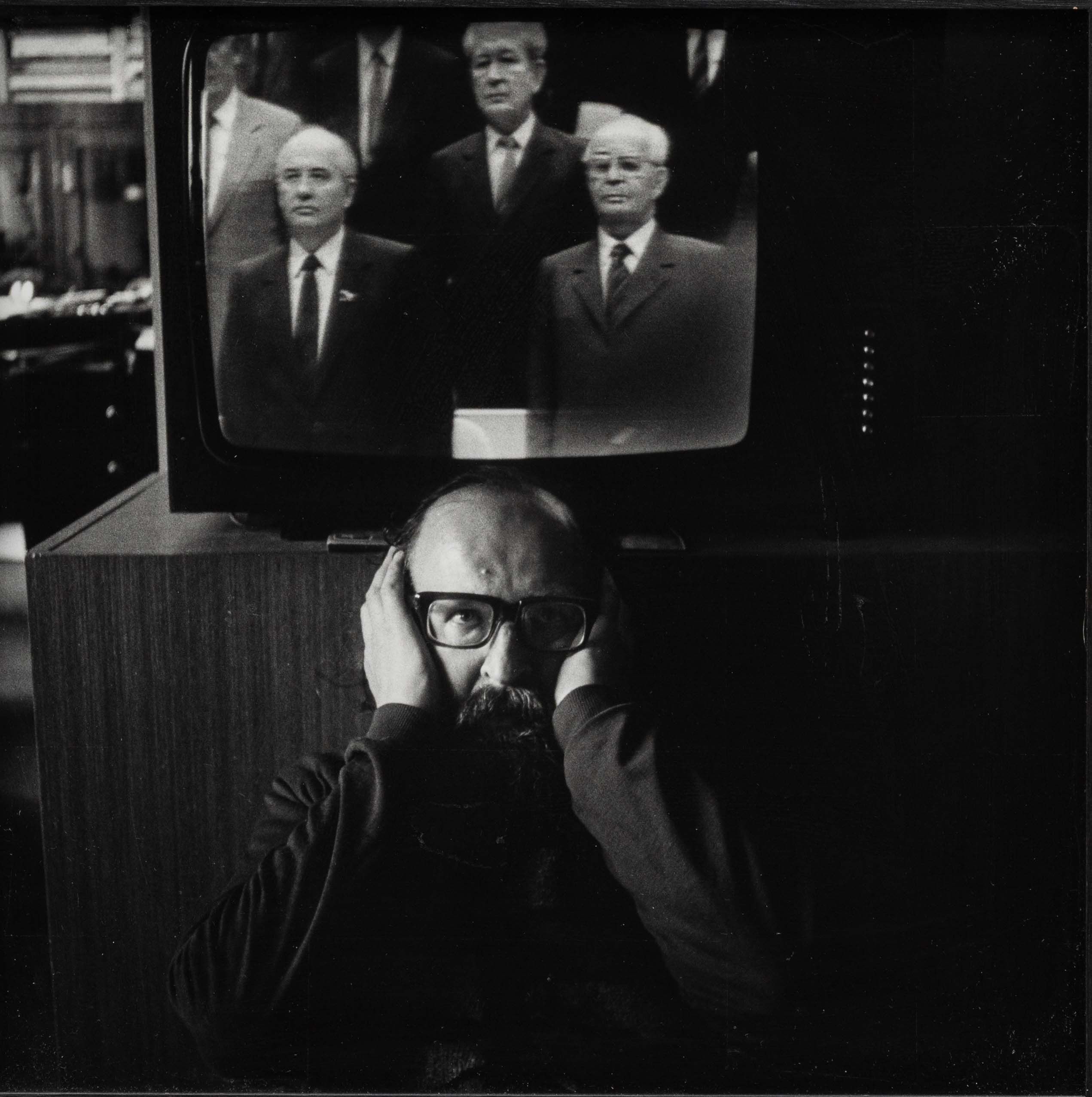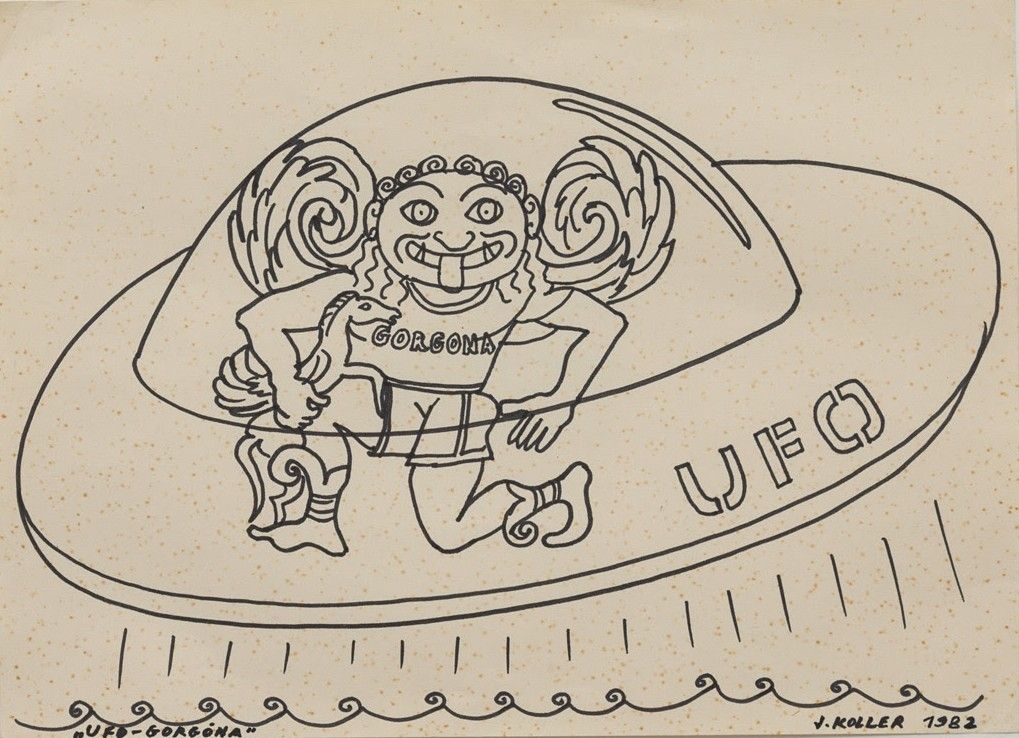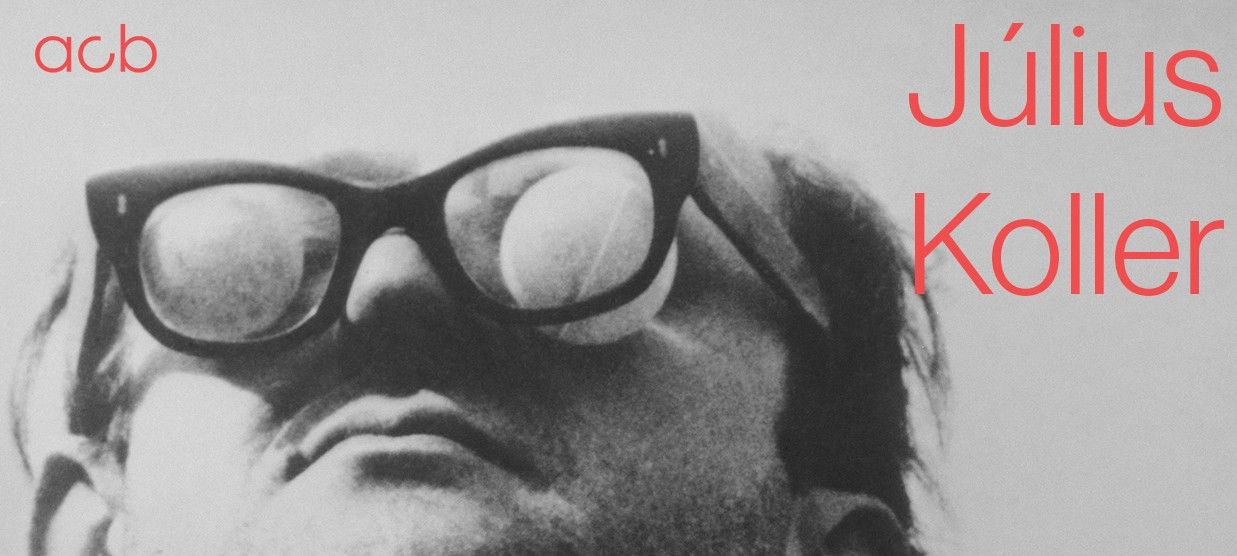Július Koller
Biography
Július Koller (Piešťany, 1939 – Bratislava, 2007) is a cult figure of the postwar avant-gardes on both sides of the former Iron Curtain. From the early 1960s, Koller occupied a marginal position in communist Czechoslovakia, developing his work from the sidelines. As a young artist, Koller critically engaged with the entire panorama of modern art, as well as the artificiality, hypocrisy, and conservatism of the official political ideology. In a spirit of proletarian modesty, he responded to the then-current avant-garde trends (Nouveau réalisme, Pop Art, and Happening), especially to their modishness and calculated arrangement, with actions directed toward everyday life and the artist’s immediate surroundings.
From 1965, he began to use the manifesto concept Antihappening, in which he announced his actively critical position toward art. He employed means of negation also in an extensive series of Anti-pictures, responding to the occupation of Czechoslovakia in 1968 and the events of the Prague Spring, he presented the question mark as a universal symbol of doubt. From 1966, he began deliberately accumulating printed materials and building an extensive register of themes, including Junk Culture, Popular Culture, Advertising, and Technology, which formed the basis of an extensive archive. With his manifesto Universal-cultural Futurological Operations, in 1970, Koller defined the work of cultural situations. The initials U.F.O., which he used to denote subjective encounters with objective space-time, became a key concept and a principal means of communication. In 1970, he presented, and subsequently each year repeated, photographic portraits of the U.F.O.-naut J.K. For the Gallery of Youth in Bratislava, he organized the action environment J. K. Ping-Pong Club, where he used the rules of “fair play” for a sporting game with the public.
In subsequent years, he appropriated sporting environments and pitches for his transformations of everyday information, objects, and situations. He announced his participation in the unofficial exhibition 1st Open Studio with a telegram UME ? NIE ! (ART ? NO !). With the onset of so called normalization (1972–1989), Koller’s public activity was restricted to teaching amateur artists. He made a living from the sale of picture-postcard paintings in the state enterprise Dielo (he likewise documented this activity as the Antihappening). His candidacy for the Union of Slovak Fine Artists was rejected in 1972. In 1973, he set up home with his lifelong partner Květoslava Fulierová. Their apartment at Kuldáková Street in the Bratislava district of Dúbravka served both as a studio and a store for their extensive archive.
Between 1971 and 1973, Koller participated in apartment meetings of a circle of Slovak conceptual artists. From the early 1970s, Koller systematically developed postal communication (Post-Art U.F.O.) with an extensive network of artists throughout the world. He thus participated in a number of important exhibitions and publications abroad. In 1980, he founded a fictitious gallery for extra-terrestrial communication, Ganek Gallery. In 1990, he initiated the foundation of the artists’ collective New Seriousness with Milan Adamčiak and Peter Rónai.
In the early 1990s, at a time of political instability (an independent Slovak Republic emerged in 1993) and rising nationalism, Koller attached the ‘idea-symbol’ of the question mark to the magic symbol of the wavy line, which he further transformed in his paintings into the oscillation of a sinusoid (Up-Down, Zig-zag, Magic Wave and Net), and compositions with frequent use of the colors of the national tricolor. Between 1988 and 1995, Koller participated in a number of performance festivals in Nové Zámky and Budapest. In 1989, he took part in the legendary underground exhibition “Suterén” (Basement), where, for the first time, he presented installations with ping-pong tables. In public spaces, he conducted performances in which he repeatedly wrote or spray-painted the symbol of the question mark and wavy line. In the 1990s, there was growing interest in his work locally and internationally.
His first independent exhibition entitled Sondy (Probes), curated by Aurel Hrabušický, was organized by the Slovak National Gallery (1991–1992). Subsequently, there were invitations to important international reviews: Second Exit in Aachen (1993), After the Spring in Sydney (1994), and the 23rd. Bienal Internacional in Sao Paulo (1996), Aspects/Positions in Vienna (1999), and Global Conceptualism in New York (1999). In 2003, Kolnischer Kunstverein presented the first independent international exhibition and publication entitled Universal Futurological Operations, curated and edited by Roman Ondák. In that same year, Koller took part in the Utopia Station project at the 50th Biennale in Venice. The galleries gb agency in Paris and Martin Janda Gallery in Vienna began presenting Koller at international art fairs. In 2005, tranzit.sk held a review exhibition, conceived by the artist himself, entitled Marec, poberáš sa starec? (It’s March, old man, aren’t you getting ready to leave?).
Works by Július Koller have been included in collections of modern and contemporary art by important institutions such as Centre Georges Pompidou, La Collection du Musée National d’Art Moderne (Paris), Centro Galego de Arte Contemporánea (Santiago de Compostela), Collección Jumex (Mexico City), Fondazione Greco Morra Collection (Naples), Museum der Moderne (Salzburg), Muzeum Sztuki Łodz (Łodz), Kontakt Collection (Vienna), Národní galerie (Prague), Tate Modern (London), and Vehbi Koc Foundation Collection (Istanbul). Koller is also represented in the collections of Slovak public art museums as well as private collections (most notably in the Linea Collection, SOGA Collection, and Zoya Collection).
Július Koller died on August 17, 2007, in Bratislava. Květoslava Fulierová donated his extensive archive to the Slovak National Gallery and the Július Koller Society (founded in 2009 by Georg Schöllhammer). The Július Koller Society, in collaboration with tranzit.sk and with the Slovak National Gallery, organized the international symposium Július Koller – U.F.O.-naut?. In 2010, the Slovak National Gallery opened the Science-Fiction Retrospective and published a catalog edited by Petra Hanáková and Aurel Hrabušický. In 2014 the Július Koller Society, in collaboration with the Museum of Modern Art (MSN) in Warsaw, the Museum moderner Kunst Stiftung Ludwig Wien (mumok), and the Kontakt Collection in Vienna, initiated an extensive research project and an international retrospective of the artist’s work One Man Anti Show (2016-2017).
Since Július Koller was rediscovered in the late 1990s, he has become an important source of inspiration for artists and intellectuals around the world. Július Koller worked with radical artistic methods that distanced his work from art’s formalisms and from all kinds of aestheticism; instead, he was creating “new cultural situations.” His art aimed at a “new life, a new creativity, and a new cosmo-humanistic culture.” His strategy was to use real objects and real life as his program of permanent operations, challenging the present to open up opportunities for alternative futures. In all his works, he therefore avoided any form of technical mastery.
Daniel Grúň


